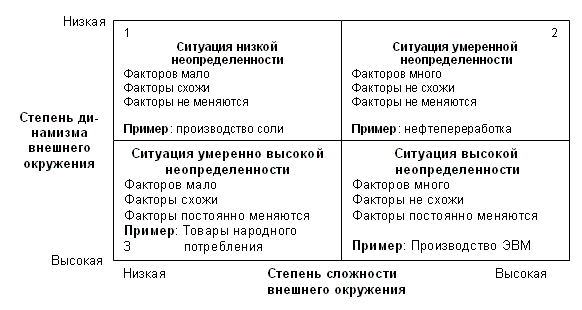home
 Management Management
 Management - Vikhanskiy OS Management - Vikhanskiy OS
|
Management - Vikhanskiy OS
1.1. External environment
Often the difference of one organization from another is explained by the difference in the environment in which they have to function. An environment external to the organization consists of two levels: the general environment and the immediate environment (this interaction is described in detail in Chapter 3).
Leaders must constantly analyze the current and, preferably, future alignment of forces in the general environment and the demands that the institutes of direct contact impose on the development of individual parts or units of the organization.
The institutions of the external environment that come with the organization in direct contact are either organizations or groups of individuals. For a specific analyzed organization, they act as intermediaries between the forces of the common environment and the units or subdivisions of the organization, forming, through the tasks that they solve, the demand for one or another function of the organization. The identification of these institutions is the first step in the design of the organization, since it helps to determine, in the first approximation, the main functional units or organizational units that, as a rule, make direct contact with one or another "intermediary" from the external environment.
The next step is to evaluate the characteristics of these institutions and their relative importance to the organization. The external environment is characterized by complexity and dynamism.
The complexity of the external environment is determined by how many factors affect the design of the organization and how these factors are similar.
The dynamism of the external environment is characterized by how rapidly the factors affecting the design of the organization change. Whether they remain basically unchanged, stable, or they change, are unstable. In our country, in connection with the transition to a market economy, the overwhelming majority of enterprises from consumers, suppliers, banks, labor, etc. The new and greatly changed requirements began to influence. In this regard, many enterprises began to revise their construction schemes, create new units, make changes to the existing services, reduce those that have lost contact with the institutions of the external environment.
Two-dimensional classification of environmental factors that affect the design of the organization can identify four types of situations, each of which most corresponds to a particular type of business. A situation characterized by low uncertainty (quadrant 1 in Figure 7.2) is the most favorable for the management of the organization.

Fig. 7.2. The main types of situations depending on the nature of environmental factors
In this case, one can expect that the external environment will not present many "surprises", and workers will definitely follow the policies and procedures adopted in the organization. The leaders themselves do not need a high level of training, long training, and extensive experience in order to successfully operate in a situation that is sufficiently clear, from the point of view of the influence of the external environment.
The situation, characterized by moderate uncertainty (quadrant 2 in Figure 7.2), is already more tense for the management of the organization. The high degree of complexity of the external environment introduces an element of considerable risk in the decision-making process. Increased risk pushes the leadership of the organization to greater alternatives in the actions. To effectively manage, managers in this situation need serious preparation and experience. For example, an oil refinery deals with many different environmental institutions: environmental protection, suppliers, consumers, foreign competitors, and so on. However, this interaction takes place within fairly stable procedures and does not undergo frequent major changes.
The situation, characterized by a moderately high uncertainty (quadrant 3 in Figure 7.2), requires the management and the organization itself to have sufficient flexibility. This is necessary due to frequent changes in the nature of interaction with environmental factors. However, the similarity of factors allows managers to cope with the situation, having a sufficient level of training and motivation. A great help to the manager in this situation is the system of electronic data processing, which allows to track changes occurring in the external environment.
A situation characterized by high uncertainty (quadrant 4 in Figure 7.2) is the greatest difficulty for the management of an organization, since the external environment is full of uncertain situations. Effective interaction of the organization and its parts with the institutions of the external environment requires top managers of the highest level of training, analytical skills and intuition. Estimates of specialists indicate that only 20% of factors in business are subject to control by the head, and the remaining 80% are uncontrollable. Among the latter are mainly environmental factors.
Each of the situations discussed above requires its own specific approach to the design of the organization and its parts. Obviously, the production of high-quality electronic equipment is possible only within the framework of complex organizations. On the other hand, such complexity is hardly needed for salt production.


Comments
When commenting on, remember that the content and tone of your message can hurt the feelings of real people, show respect and tolerance to your interlocutors even if you do not share their opinion, your behavior in the conditions of freedom of expression and anonymity provided by the Internet, changes Not only virtual, but also the real world. All comments are hidden from the index, spam is controlled.